Discover the Majestic Yingxian Wooden Pagoda: A Marvel of Ancient Architecture
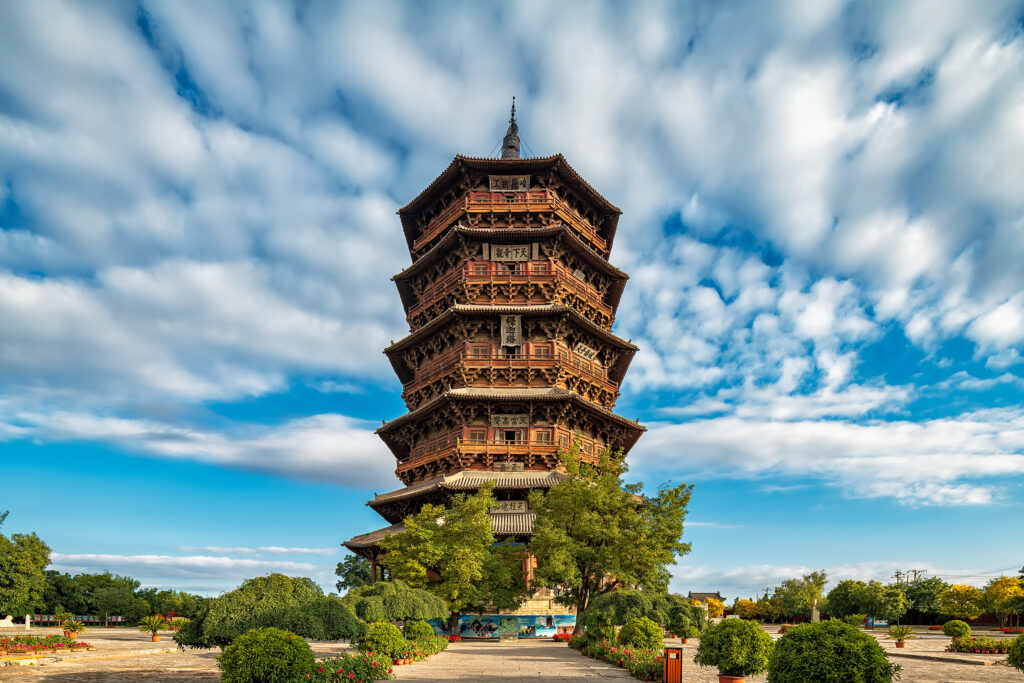
An Essential Guide to Visiting Yingxian Wooden Pagoda
In This Guide
- An Essential Guide to Visiting Yingxian Wooden Pagoda
- The Rich History and Legends of Yingxian Wooden Pagoda
- Main Highlights: What You Absolutely Can’t Miss
- Planning Your Visit: A Practical Guide
- Tickets: Prices, Booking, and Tips
- How to Get There: A Complete Transportation Guide
- Local Cuisine and Accommodation Nearby
- Frequently Asked Questions
- Final Thoughts on Your Trip
Nestled in the serene landscape of Shanxi Province, the Yingxian Wooden Pagoda, also known as the Sakyamuni Pagoda of Fogong Temple, stands as a monumental testament to ancient Chinese craftsmanship and spirituality. This architectural marvel, which dates back to 1056 AD during the Liao Dynasty, holds the title of the tallest and oldest wooden pagoda in the world. Towering at an impressive 67.31 meters (221 feet), it is not only a sight to behold but also a symbol of resilience, having survived centuries of natural disasters, wars, and the test of time—all without the aid of a single iron nail.
As you approach the pagoda, the air is filled with a sense of history that beckons you to explore its intricacies. The structure’s unique design, comprising nine levels with five visible stories, showcases the ingenuity of traditional Chinese architecture, utilizing over 62 types of mortise-and-tenon joints—each joint a piece of an intricate puzzle that has withstood over 40 earthquakes and countless artillery strikes.
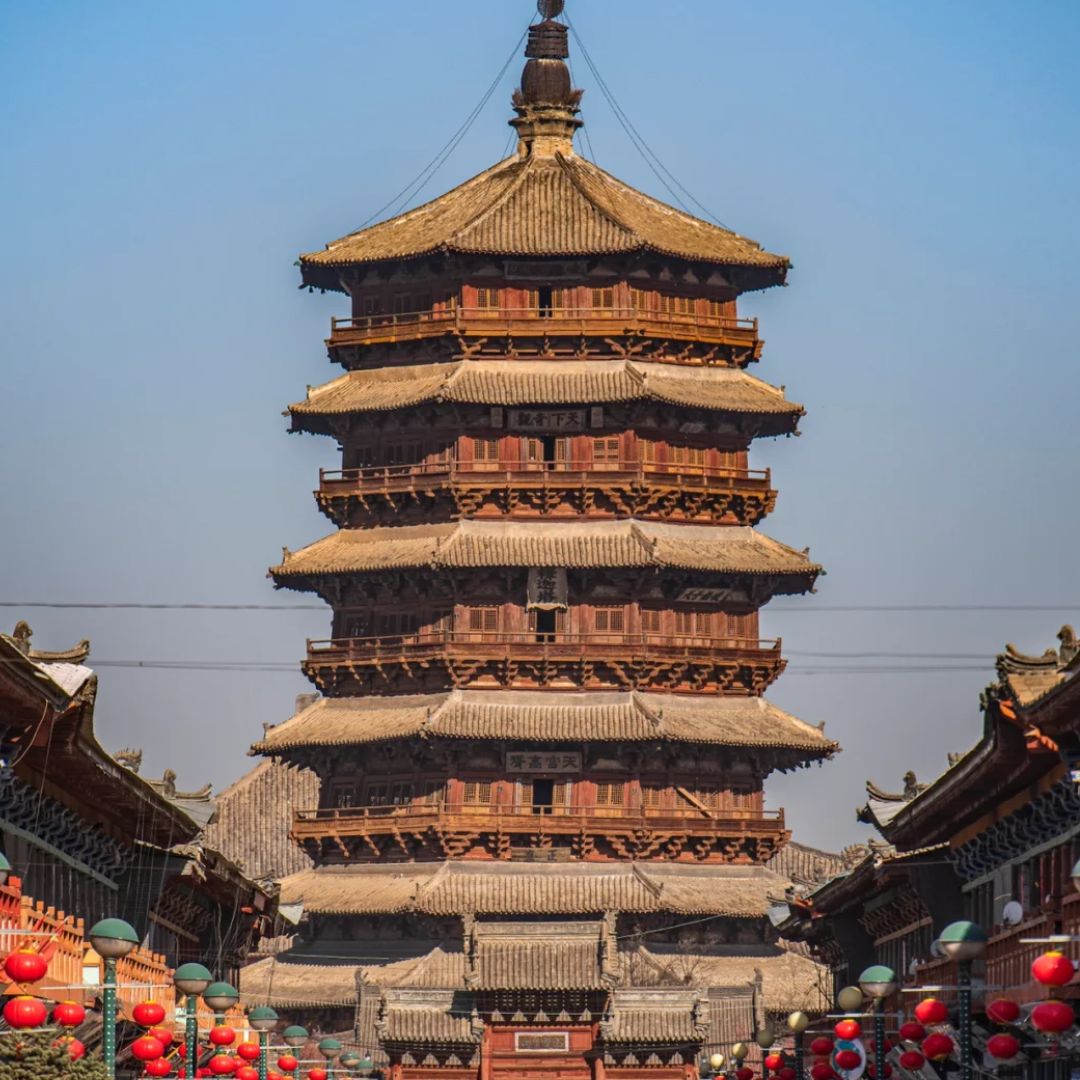
Yingxian Wooden Pagoda.
Visiting the Yingxian Wooden Pagoda is more than just a trip to a historical site; it is an opportunity to delve into the rich tapestry of Chinese culture and spirituality. The pagoda, once a place of worship commissioned by Empress Dowager Xiao to promote peace and Buddhism, continues to inspire awe. As you wander through its surroundings, you’ll find not only architectural beauty but also a peaceful atmosphere that invites reflection and admiration.
Whether you’re an architecture aficionado, a history buff, or simply a curious traveler, the Yingxian Wooden Pagoda offers a glimpse into the past that is both captivating and enlightening. Prepare to be enchanted by one of China’s most extraordinary historical gems, where every beam tells a story, and every moment spent here is steeped in the echoes of centuries gone by.
The Rich History and Legends of Yingxian Wooden Pagoda
A Journey Through Time: The Rich History and Legends of Yingxian Wooden Pagoda
Nestled in the serene landscape of Yingxian County in Shanxi Province, the Yingxian Wooden Pagoda, also known as the Sakyamuni Pagoda of Fogong Temple, stands as a monumental testament to Chinese architectural ingenuity and spiritual devotion. Erected in 1056 AD during the Liao Dynasty, this pagoda is not only the tallest wooden pagoda in the world but also the oldest, having withstood the trials of time, including earthquakes and wars, without the use of a single iron nail.
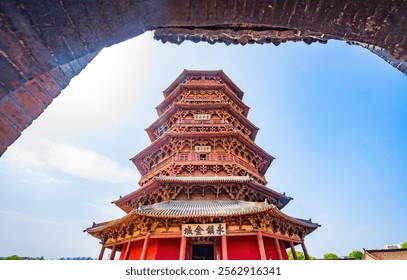
Yingxian Wooden Pagoda.
Historical Significance
Commissioned by Empress Dowager Xiao, a fervent Buddhist, the pagoda was constructed to promote Buddhism and pray for peace in a region often marred by conflict. The architectural brilliance of the pagoda lies in its unique construction method, utilizing traditional mortise-and-tenon joints. Over 62 types of these wooden joints have been identified, showcasing the exceptional craftsmanship of the era. The structure, rising to 67.31 meters (221 feet), comprises nine levels, with five visible stories and four hidden layers, embodying a “tower within a tower” design that enhances its stability.
Throughout its long history, the Yingxian Wooden Pagoda has undergone several renovations, with the most significant occurring in 1935. Unfortunately, this renovation, which altered some of the critical supports, led to structural challenges that currently limit public access to the ground floor. Nonetheless, the pagoda remains a marvel of ancient engineering and a symbol of resilience.
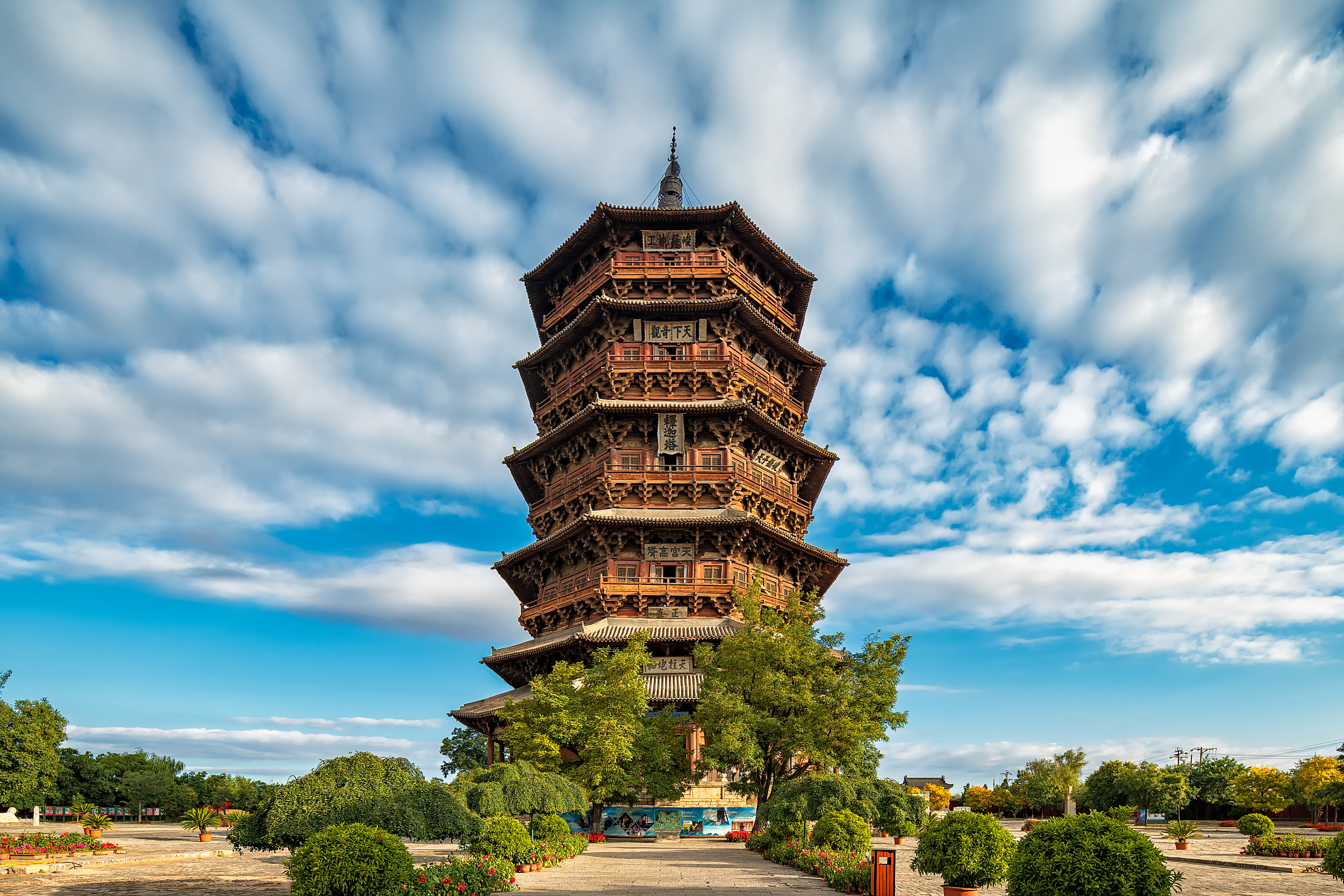
Yingxian Wooden Pagoda.
Legends and Cultural Heritage
The pagoda is steeped in legends that add to its allure. One popular tale tells of a dragon spirit that protects the pagoda and the surrounding area. It is said that this spirit awakens during times of danger, ensuring that the pagoda remains intact amidst earthquakes and storms. Local folklore also claims that the spirit blesses visitors with peace and prosperity, making it a popular pilgrimage site for those seeking spiritual solace.
Another fascinating legend involves the towering statue of the Shakyamuni Buddha housed within the pagoda. Standing at 11 meters tall, this clay statue is one of the tallest indoor mud sculptures in China. According to local belief, the statue contains sacred Buddhist scriptures, which were once hidden within its hollowed body. It is said that reverent offerings made to the statue have led to miraculous events, reinforcing the pagoda’s significance in the spiritual landscape of China.
Architectural Marvel
The Yingxian Wooden Pagoda’s architectural features are as legendary as its stories. The intricate dougong brackets—a traditional Chinese architectural element—can be found throughout the structure and are considered some of the most elaborate in any surviving ancient building. These interlocking wooden pieces not only provide structural support but also contribute to the aesthetic beauty of the pagoda. Visitors can marvel at the thousands of these brackets, each meticulously crafted and fitted, resembling a wooden puzzle that has stood the test of time.

Yingxian Wooden Pagoda.
Outside, the pagoda is surrounded by lush greenery and ancient trees, where swallows dart gracefully and cats roam freely, serving as the furry guardians of this historic site. The presence of ancient plaques and inscriptions from the Ming and Qing dynasties further enhances the cultural tapestry of the area, inviting visitors to reflect on the rich history encapsulated within its walls.
Conclusion
The Yingxian Wooden Pagoda is not merely a structure; it is a living testament to the spiritual and architectural heritage of China. Its history, interwoven with legends and cultural significance, makes it a must-visit destination for travelers seeking to explore the depths of Chinese history and culture. As you stand before this majestic pagoda, you are not just an observer of ancient artistry; you are a part of its ongoing story, a narrative that began nearly a millennium ago.
Main Highlights: What You Absolutely Can’t Miss
Discover the Marvels of Yingxian Wooden Pagoda
When exploring the historical depths of China, the Yingxian Wooden Pagoda stands out as a beacon of architectural ingenuity and cultural significance. This remarkable structure offers visitors a glimpse into the artistry of the Liao Dynasty and the enduring principles of Buddhism. Here are the main highlights of what you absolutely cannot miss during your visit.
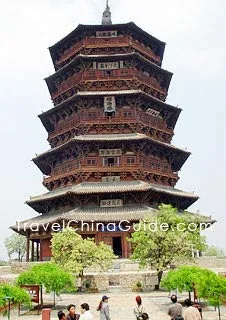
Yingxian Wooden Pagoda.
The World’s Tallest and Oldest Wooden Pagoda
-
Historical Significance: Erected in 1056 AD under Empress Dowager Xiao, this pagoda is a testament to the Liao Dynasty’s devotion to Buddhism and peace. Standing at 67.31 meters (221 feet), it is the tallest wooden pagoda globally and has survived centuries of natural and man-made calamities.
-
Ingenious Construction: What makes the Yingxian Wooden Pagoda truly extraordinary is its construction without a single iron nail. Instead, it employs over 62 types of mortise-and-tenon joints, showcasing the unparalleled craftsmanship of ancient builders.
Architectural Marvels
-
Unique Design: The pagoda features an intricate octagonal structure that is both elegant and resilient. The design includes an inner and outer ring of columns, effectively forming a “tower within a tower.” This ingenious layout has allowed it to withstand more than 40 earthquakes and over 200 artillery strikes.
-
Exquisite Details: As you approach, take note of the thousands of interlocking dougong brackets—each piece meticulously crafted and fitted together, resembling a wooden puzzle. This pagoda is believed to possess the highest number of dougong forms among surviving ancient structures in China.
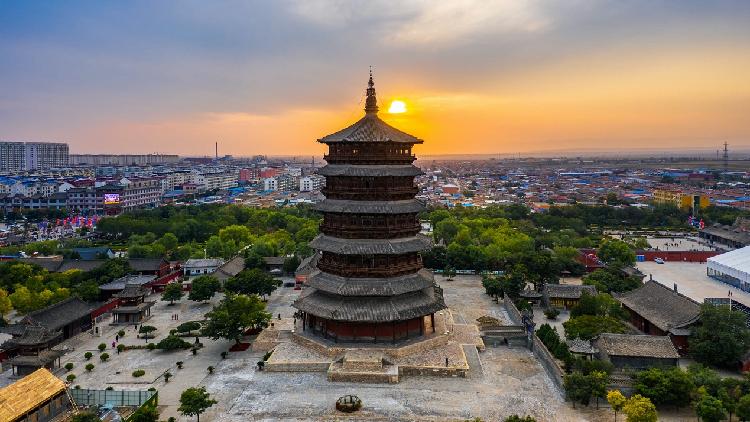
Yingxian Wooden Pagoda.
Breathtaking Surroundings
-
Natural Beauty: Set against a backdrop of towering trees and expansive skies, the pagoda’s weathered timber glows in the sunlight, creating a serene atmosphere. Watch for swallows darting gracefully around, while local cats, beloved by visitors, add a charming touch to the scene.
-
Cultural Artifacts: The area surrounding the pagoda is dotted with ancient plaques from the Ming and Qing dynasties, masterpieces of calligraphy that tell stories of the past.
Inside the Pagoda
-
Sacred Art: The ground floor houses an impressive 11-meter-tall clay statue of Shakyamuni Buddha, one of the tallest indoor mud sculptures in China. Intriguingly, the statue has two distinct patches on its chest, remnants from when it was hollowed to retrieve sacred Buddhist scriptures.
-
Stunning Ceiling and Murals: Look up to admire the richly painted ceiling that resembles a heavenly canopy, adorned with vibrant murals and intricate sculptures, including a small dragon that curls around a column, supporting the Buddha’s base.
Visiting Tips
-
Best Time to Visit: Spring (March to May) and autumn (September to November) offer ideal weather and fewer crowds, enhancing your experience. However, the pagoda can be explored year-round.
-
Respect the Heritage: As you wander, remember to keep your distance from the ancient wooden structures. Open flames, including candles and incense, are strictly prohibited to preserve the site.
-
Photography Opportunities: For stunning photos, use the surrounding trees as a foreground. Capture the pagoda from various angles, especially from beneath the eaves of the bell tower or in front of the Paifang (archway) at Xiaoxitian.
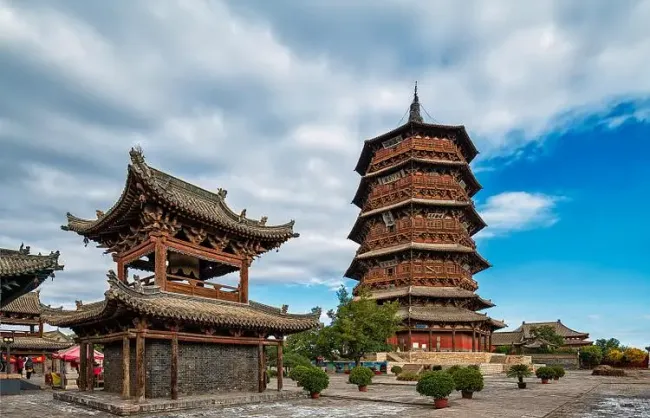
Yingxian Wooden Pagoda.
Planning Your Visit
-
Location and Transportation: Situated about 75 km (47 miles) south of Datong, the pagoda is accessible via private car, high-speed train, or direct tourist bus, making it a convenient stop during your travels through Shanxi Province.
-
Suggested Itinerary: Consider combining your visit with other nearby attractions, such as the Hanging Temple and the Yungang Grottoes, to enrich your journey through this historically rich region.
The Yingxian Wooden Pagoda is not just an architectural wonder; it is a living testament to China’s rich cultural tapestry. Every corner of this magnificent structure invites you to delve deeper into the stories and traditions that have shaped its existence over nearly a millennium. Make sure this extraordinary site is on your itinerary—it’s an experience you won’t soon forget!
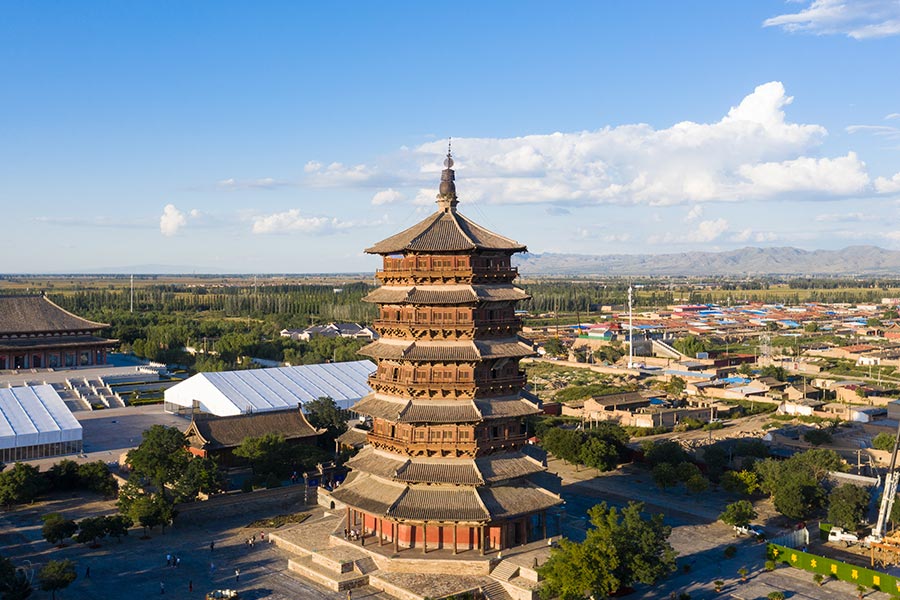
Yingxian Wooden Pagoda.
Planning Your Visit: A Practical Guide
Discovering the Yingxian Wooden Pagoda: A Practical Guide for Travelers
Nestled in the serene surroundings of Yingxian County, the Yingxian Wooden Pagoda, or Sakyamuni Pagoda of Fogong Temple, stands as a testament to Chinese architectural ingenuity and Buddhist devotion. This ancient structure, completed in 1056 during the Liao Dynasty, is recognized as the tallest and oldest wooden pagoda in the world. For those intrigued by history and culture, planning a visit to this remarkable site promises an enriching experience.
Essential Information
- Chinese Name: 应县木塔 (Yìngxiàn Mùtǎ)
- Height: 67.31 meters (221 feet)
- Floors: 9 levels (5 visible, 4 hidden)
- Location: Yingxian County, Datong City, Shanxi Province
- Opening Hours: 8:00 AM – 5:00 PM (hours may vary seasonally)
- Admission Fee: RMB 50 (approximately USD 6.90)
- Duration of Visit: 1–2 hours
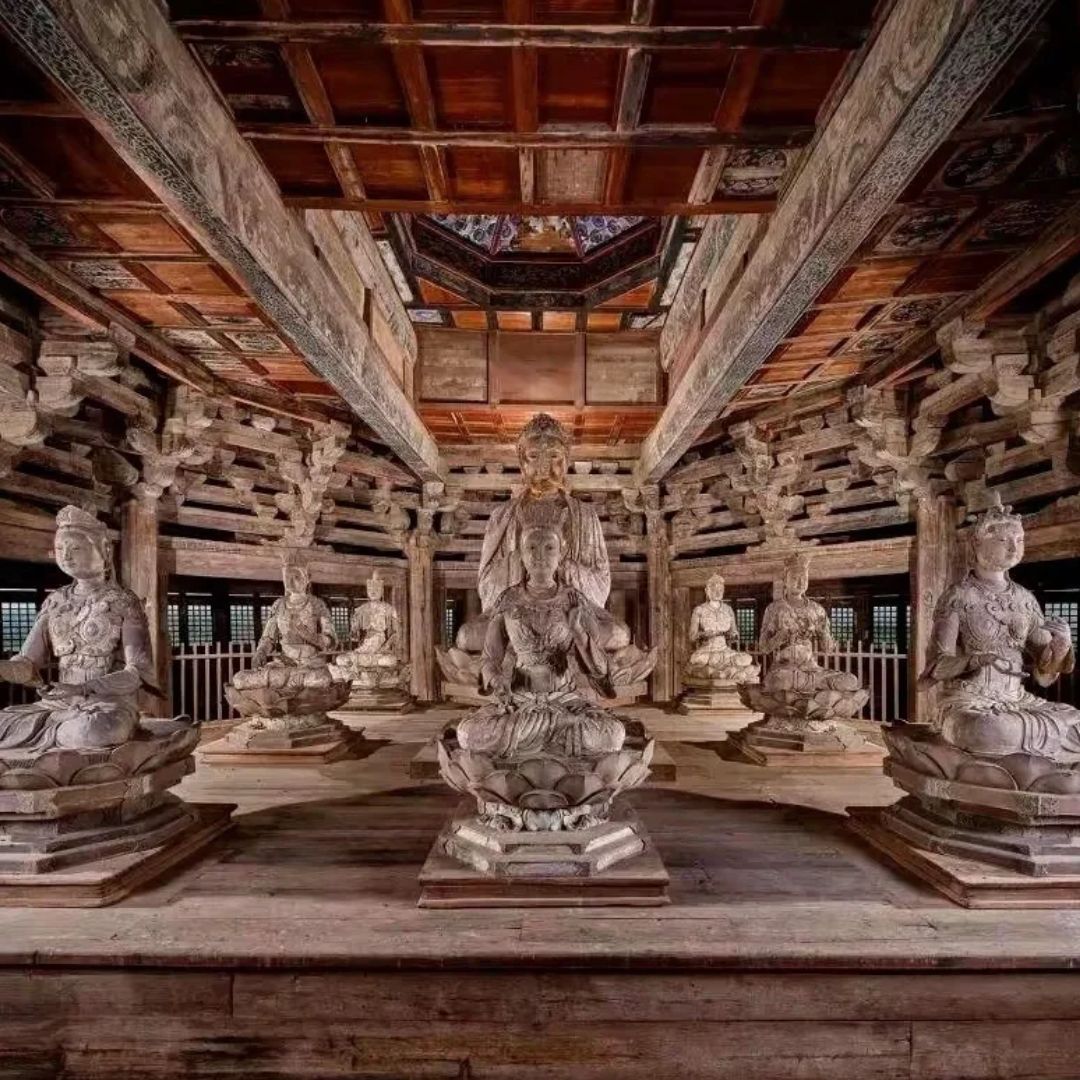
Yingxian Wooden Pagoda.
Historical Significance
The pagoda was commissioned by Empress Dowager Xiao, a devoted Buddhist, to promote peace in a region that had seen much conflict. Built entirely of wood using traditional mortise-and-tenon techniques—without a single iron nail—this architectural marvel has withstood the test of time, enduring earthquakes and wars.
Getting There
Traveling to the Yingxian Wooden Pagoda from Datong, a major city in Shanxi Province, can be accomplished via several transportation options:
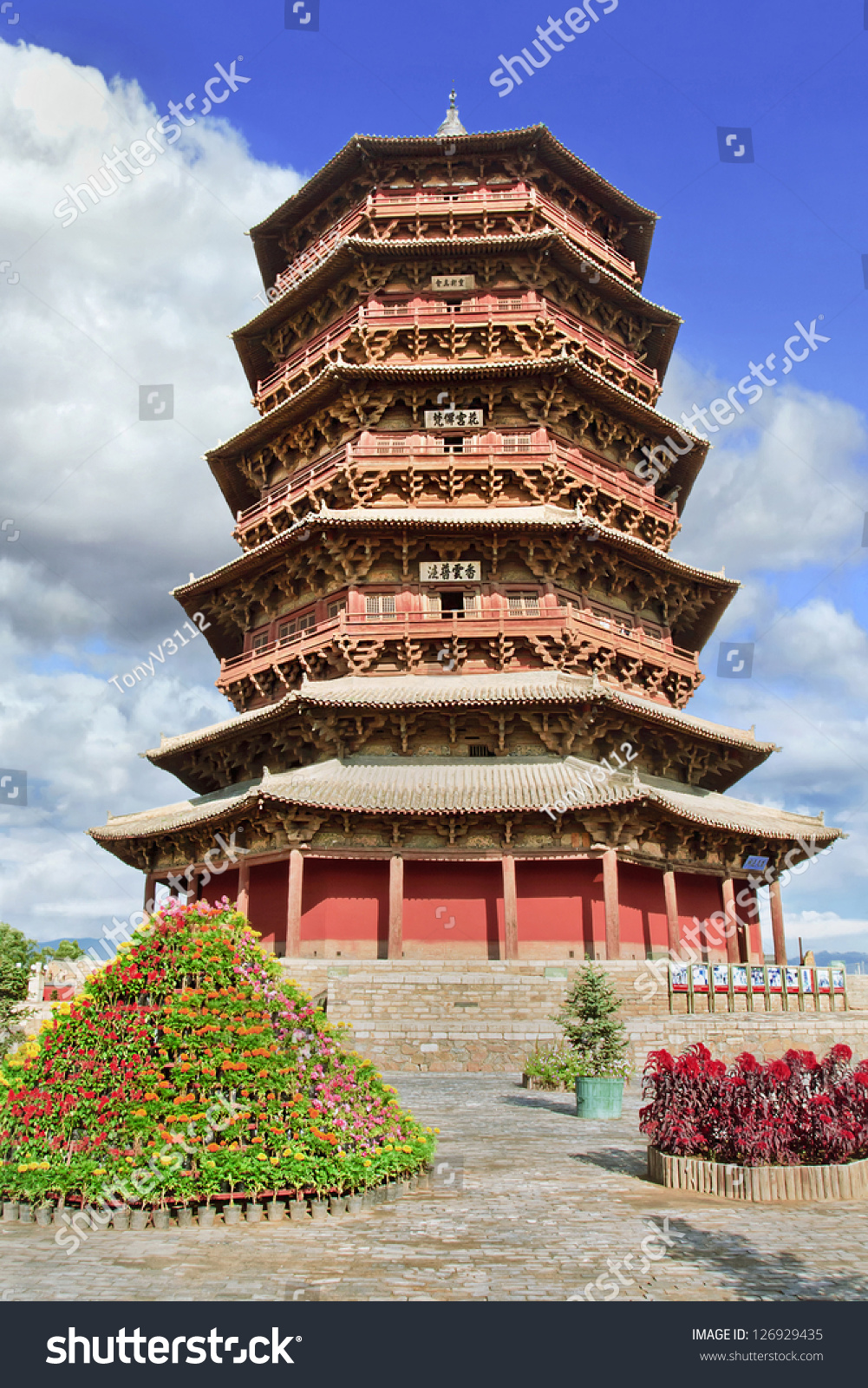
Yingxian Wooden Pagoda.
-
Private Car: The most convenient way is to hire a private car, taking approximately 1 hour from Datong. Consider booking a private tour for a comfortable experience.
-
High-Speed Train: Take a high-speed train from Datong South Station to Yingxian West Station. The journey lasts about 20–30 minutes and costs around RMB 25. From the station, a taxi ride to the pagoda will take another 20–30 minutes.
-
Direct Tourist Bus: There’s a direct tourist bus connecting Datong Ancient City to the pagoda, with a travel time of around 75 minutes and a ticket price of RMB 39.
What to Expect During Your Visit
As you approach the pagoda, its towering octagonal structure will captivate you. The wooden beams, meticulously crafted with over 62 types of joints, reflect the outstanding craftsmanship of the period. Here’s what you can look forward to:
-
Architectural Highlights: The pagoda features a unique “tower within a tower” design, supported by an inner and outer ring of columns, which has helped it endure numerous natural disasters.
-
Rich Interior: Inside, you will find an impressive 11-meter-tall clay statue of the Shakyamuni Buddha, surrounded by intricate murals and sculptures. The ceiling is adorned with vibrant colors, resembling a heavenly canopy.
-
Historical Artifacts: Look for ancient plaques from the Ming and Qing dynasties, showcasing exquisite examples of Chinese calligraphy.

Yingxian Wooden Pagoda.
Tips for Your Visit
-
Best Time to Visit: Spring (March to May) and autumn (September to November) offer pleasant weather and fewer crowds, enhancing your experience.
-
Respect the Site: Avoid touching or leaning on the wooden structures, and refrain from using open flames to prevent fire hazards.
-
Photography: Capture the pagoda’s beauty by framing it with surrounding trees or using low-angle shots for unique perspectives.
Suggested Itinerary
To make the most of your trip to the Datong region, consider a two-day itinerary:
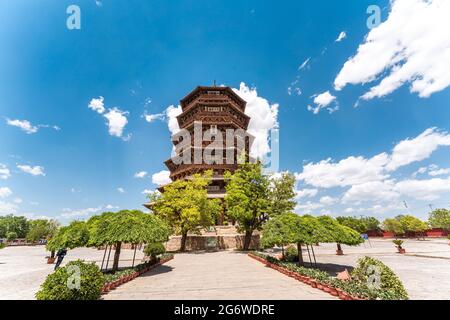
Yingxian Wooden Pagoda.
-
Day 1: Arrive in Datong and explore the Yungang Grottoes, a UNESCO World Heritage Site, which is about a 45-minute drive from the city center.
-
Day 2: Start early with a visit to the Hanging Temple, followed by the Yingxian Wooden Pagoda. You may also take time to enjoy local cuisine in Yingxian County before returning to Datong.
For a more relaxed pace, dedicate additional time to explore local temples and sample Shanxi-style noodles at nearby eateries.
Conclusion
The Yingxian Wooden Pagoda is not just a structure; it is a narrative of faith, resilience, and architectural brilliance that has transcended centuries. By planning your visit thoughtfully, you will not only witness a marvel of ancient engineering but also immerse yourself in the rich tapestry of Chinese history and culture. Prepare for a memorable journey that will leave you with lasting impressions of this extraordinary site.
Tickets: Prices, Booking, and Tips
Visiting the Yingxian Wooden Pagoda, an architectural marvel and a testament to ancient craftsmanship, is an unforgettable experience for anyone intrigued by Chinese history and culture. Here’s everything you need to know about tickets, pricing, booking, and essential tips to enhance your visit.
Ticket Information
- Price:
-
The admission fee for the Yingxian Wooden Pagoda is RMB 50 (approximately USD 6.90 or SGD 9.40).
-
Opening Hours:
-
The pagoda is open to visitors from 8:00 AM to 5:00 PM. Note that hours may vary slightly with the seasons, so it’s advisable to check in advance if you’re planning a visit during off-peak times.
-
Duration of Visit:
- Plan to spend 1 to 2 hours exploring the site, allowing enough time to appreciate the intricate details of the pagoda and the surrounding area.
Booking Your Visit
- Advance Booking:
-
While tickets can often be purchased on-site, consider booking in advance during peak tourist seasons (spring and autumn) to avoid long lines. Some travel agencies also offer packaged tours that include entrance fees.
-
Getting There:
- The Yingxian Wooden Pagoda is located about 75 km (47 miles) south of Datong City. You can reach it via several transportation options:
- Private Car: The most comfortable choice, taking approximately 1 hour. Booking a private tour can provide a hassle-free experience.
- High-Speed Train: A quick and affordable option, trains from Datong South Station to Yingxian West Station take about 20-30 minutes with tickets costing around RMB 25 (USD 3.50).
- Direct Tourist Bus: A convenient bus service connects Datong Ancient City to the pagoda, taking about 75 minutes with tickets priced at RMB 39 (USD 5.40).
Tips for a Smooth Visit
- Best Time to Visit:
-
The ideal times are during spring (March to May) and autumn (September to November). The weather is pleasant, and the natural scenery enhances the beauty of the pagoda.
-
Respect the Site:
-
Preserve the integrity of this ancient structure by refraining from touching or leaning on the wooden beams. Remember, these elements have withstood the test of time for nearly a millennium.
-
Safety Regulations:
-
To minimize fire hazards, the use of candles, incense, and smoking is strictly prohibited within the vicinity of the pagoda.
-
Photography Tips:
- For stunning photos, use the surrounding trees as natural frames. To capture the grandeur of the pagoda, consider taking low-angle shots from the base of nearby structures like the bell tower or the archway known as Paifang.
By following these guidelines, you can make the most of your visit to the Yingxian Wooden Pagoda. This extraordinary site not only offers a glimpse into China’s rich history but also exemplifies the remarkable artistry of ancient Chinese architecture. Enjoy your journey through time at this iconic landmark!
How to Get There: A Complete Transportation Guide
Journey to the Yingxian Wooden Pagoda: Your Transportation Guide
Visiting the Yingxian Wooden Pagoda, the tallest and oldest wooden pagoda in the world, is an unforgettable experience steeped in history and architectural marvel. Situated approximately 75 kilometers south of Datong in Shanxi Province, reaching this ancient site can be done in several convenient ways. Here’s how to navigate your journey to this remarkable structure.
1. Private Car
Best for Comfort and Flexibility
Traveling by private car is the most comfortable and direct option. The drive from Datong to the pagoda takes about 1 hour, allowing you to enjoy the scenic landscapes of Shanxi Province along the way.
- Recommendation: For a hassle-free experience, consider booking a private tour with local operators such as China Highlights. They provide comfortable vehicles and knowledgeable local drivers who can pick you up directly from your hotel.
2. High-Speed Train
Fast and Efficient
For those who prefer a quicker route, taking a high-speed train is an excellent choice.
- Departure: Board the train at Datong South Station (大同南站).
- Duration: The journey to Yingxian West Station (应县西站) takes approximately 20–30 minutes.
- Cost: Tickets are roughly RMB 25 (about USD 3.50 or SGD 4.80).
- Post-Arrival: Once you arrive at Yingxian West Station, you can easily grab a taxi for a 20–30 minute ride to the pagoda.
3. Direct Tourist Bus
Budget-Friendly and Direct
Another convenient option is the direct tourist bus, which operates between Datong and the Yingxian Wooden Pagoda.
- Departure Point: Buses leave from Datong Ancient City.
- Duration: The bus ride takes around 75 minutes.
- Cost: Tickets are priced at RMB 39 (approximately USD 5.40 or SGD 7.50).
4. Itinerary Suggestions
If you’re planning to explore the region thoroughly, consider a two-day itinerary that includes visits to other notable sites in Datong.
- Day 1: Arrive in Datong and visit the Yungang Grottoes. Spend the afternoon exploring these incredible ancient Buddhist carvings.
- Day 2: Start with the Hanging Temple, a stunning temple built into a cliff, then proceed to the Yingxian Wooden Pagoda. This allows you to appreciate the beauty of both sites without feeling rushed.
Traveling Tips
- Best Time to Visit: Spring (March to May) and autumn (September to November) offer the most pleasant weather and fewer crowds, enhancing your experience at the pagoda.
- Respect the Site: Remember not to touch or lean on the wooden structures to help preserve their integrity for future generations.
- Photography: Capture the pagoda amidst the surrounding trees or take low-angle shots for a unique perspective.
No matter which transportation option you choose, the journey to the Yingxian Wooden Pagoda promises to be as enriching as the destination itself. Embrace the beauty and history of this ancient structure and enjoy every moment of your visit!
Local Cuisine and Accommodation Nearby
Exploring the Yingxian Wooden Pagoda offers a glimpse into the grandeur of ancient Chinese architecture, but your journey doesn’t have to end there. The surrounding area is rich in local flavors and comfortable accommodations, ensuring you can immerse yourself fully in the culture of Shanxi Province.
Local Cuisine: A Taste of Shanxi
When visiting Yingxian, indulging in the local cuisine is a must. Shanxi is renowned for its unique flavors and traditional dishes. Here are some local specialties to seek out:
- Shanxi Noodles (山西刀削面): These hand-sliced noodles are a signature dish of the region. Served in a rich broth with various toppings, they offer a delightful texture and taste.
- Vinegar (山西老陈醋): Shanxi is famous for its aged vinegar, which adds depth to many dishes. Sample it in dipping sauces or as a seasoning in stir-fried meals.
- Braised Pork (红烧肉): Tender and flavorful, this dish features pork belly braised in soy sauce, sugar, and spices, creating a savory, sweet profile that is hard to resist.
- Spicy Hot Pot (火锅): While hot pot is enjoyed throughout China, Shanxi puts its own twist on this communal dining experience with local ingredients and spices.
For a truly authentic experience, consider dining at a local eatery in Yingxian County. Here are a couple of popular spots to try:
- Yingxian Old Noodle Shop (应县老面馆): Known for its fresh, hand-pulled noodles and hearty broths, this eatery is a favorite among locals and visitors alike.
- Huaiyang Restaurant (淮阳餐厅): This local restaurant specializes in a variety of Shanxi dishes, with a cozy atmosphere and friendly service.
Accommodation: Resting Near History
After a day of exploring the pagoda and indulging in local fare, finding a comfortable place to stay is essential. Here are some recommended accommodations nearby:
-
Yingxian Cultural Hotel (应县文化酒店): Located just a short drive from the pagoda, this hotel offers modern amenities blended with traditional decor. Guests appreciate the comfortable rooms and easy access to local attractions.
-
Shanxi Yingxian Hotel (山西应县宾馆): This well-regarded hotel provides a range of services, including free Wi-Fi and breakfast options. Its central location makes it convenient for exploring the town and the pagoda.
-
Da Tong Xiang Hotel (大同祥酒店): If you prefer to stay in Datong, this hotel is about an hour’s drive from Yingxian. It features comfortable rooms and a restaurant serving both local and international cuisine.
Conclusion
Exploring the Yingxian Wooden Pagoda is not merely about witnessing a historical marvel; it’s an opportunity to dive into the rich tapestry of Shanxi culture through its cuisine and hospitality. Whether savoring the flavors of local dishes or resting in charming accommodations, your experience will be enhanced, making your visit to this remarkable site a memorable one.
Frequently Asked Questions
Frequently Asked Questions about Yingxian Wooden Pagoda
1. What is the Yingxian Wooden Pagoda?
The Yingxian Wooden Pagoda, also known as the Sakyamuni Pagoda of Fogong Temple, is the tallest and oldest wooden pagoda in the world. Built in 1056 AD during the Liao Dynasty, it stands at 67.31 meters (221 feet) tall and is renowned for its remarkable wooden construction, which utilizes traditional mortise-and-tenon joints without any iron nails.
2. How do I get to the Yingxian Wooden Pagoda from Datong?
There are several convenient options to reach the pagoda from Datong:
– Private Car: The quickest way, taking about 1 hour. Booking a private tour can enhance your experience with comfort and ease.
– High-Speed Train: A 20–30 minute ride from Datong South Station to Yingxian West Station, costing around RMB 25 (USD 3.50). Taxis are available at the station for the final leg of the journey.
– Direct Tourist Bus: This bus connects Datong Ancient City to the pagoda, taking about 75 minutes and costing RMB 39 (USD 5.40).
3. What are the opening hours and admission fees?
The Yingxian Wooden Pagoda is generally open from 8:00 AM to 5:00 PM, but hours may vary seasonally. The admission fee is RMB 50 (approximately USD 6.90).
4. What can I expect to see during my visit?
Visitors can marvel at the pagoda’s architectural brilliance, including its intricate wooden joints and the stunning octagonal design. Inside, you will find an 11-meter-tall clay statue of the Shakyamuni Buddha and beautiful murals. The first floor is accessible, while the upper levels are restricted for safety reasons.
5. When is the best time to visit the pagoda?
The ideal months to visit are spring (March to May) and autumn (September to November) when the weather is pleasant and the scenery around the pagoda is particularly beautiful. Visiting during these seasons also helps avoid larger crowds.
6. Are there any rules or guidelines for visitors?
Yes, to preserve this ancient structure, visitors should:
– Avoid touching or leaning on wooden beams.
– Refrain from using open flames, including candles and incense.
– Respect the site’s tranquility and refrain from loud noises.
7. Can I take photographs at the pagoda?
Absolutely! Photography is encouraged. For stunning shots, consider using the surrounding trees for foreground interest and the sky for a clean background. Low-angle shots from designated areas, like beneath the bell tower eaves, can yield spectacular results.
8. How should I plan my visit in conjunction with other attractions?
If you aim to explore Datong’s major highlights, consider a two-day itinerary. On the first day, visit the Yungang Grottoes, and on the second day, start with the Hanging Temple before heading to the Yingxian Wooden Pagoda. This allows for a more relaxed pace and a thorough experience of the area’s rich history and culture.
Final Thoughts on Your Trip
As you wrap up your journey to the Yingxian Wooden Pagoda, take a moment to reflect on the rich tapestry of history and craftsmanship that this remarkable site embodies. Standing tall for nearly a millennium, this architectural marvel is not just a testament to ancient engineering but also a symbol of resilience, spirituality, and the enduring spirit of Chinese culture.
A Few Final Thoughts:
-
A Connection to History: Visiting the pagoda offers a unique opportunity to connect with the past, standing in the same space where Empress Dowager Xiao once prayed for peace. The stories etched in its wooden beams remind us of the countless lives that have intersected here over the centuries.
-
Natural Beauty: Surrounded by serene landscapes, the pagoda invites you to appreciate not only its architectural grandeur but also the tranquil beauty of Yingxian County. Allow yourself some time to explore the peaceful streets and savor local delicacies like Shanxi-style noodles, which provide a delicious glimpse into the region’s culinary heritage.
-
Cultural Insights: The intricate carvings, ancient plaques, and the towering statue of Shakyamuni Buddha within the pagoda reveal the depth of Buddhist art and philosophy that has shaped Chinese culture. Each element of the structure offers insights into the religious devotion and artistic expression of the time.
-
Respect for Heritage: As you leave this iconic landmark, remember that preserving such treasures is a shared responsibility. Your respect for the site, by refraining from touching the ancient wood and observing the rules in place, contributes to its longevity for future generations.
In conclusion, your visit to the Yingxian Wooden Pagoda is more than just a sightseeing excursion; it is an immersion into the heart of Chinese history and spirituality. Whether you are an architecture enthusiast, a history buff, or a seeker of spiritual solace, this pagoda is sure to leave an indelible mark on your travel experience. Embrace the stories you’ve encountered here, and carry them with you as you continue your journey through the wonders of China. Safe travels!